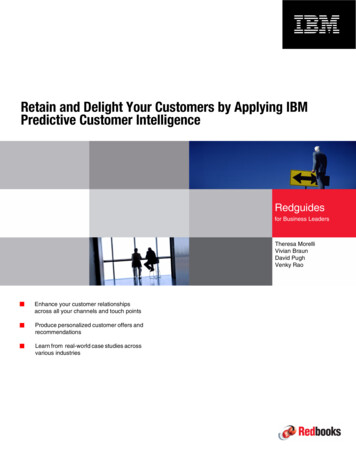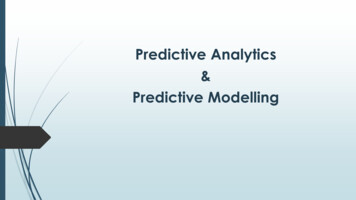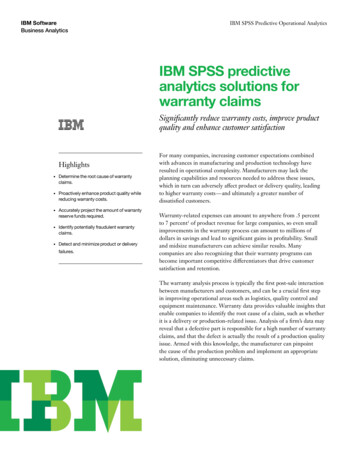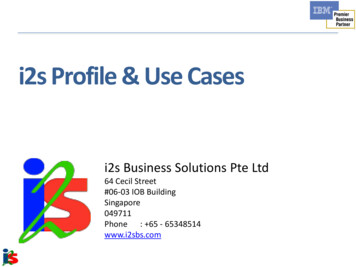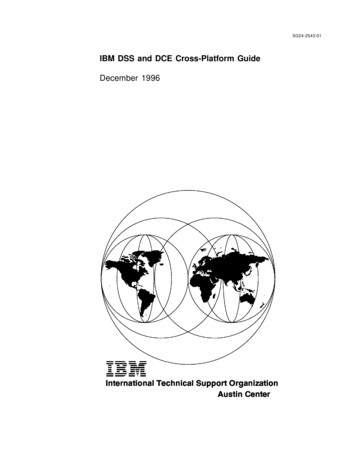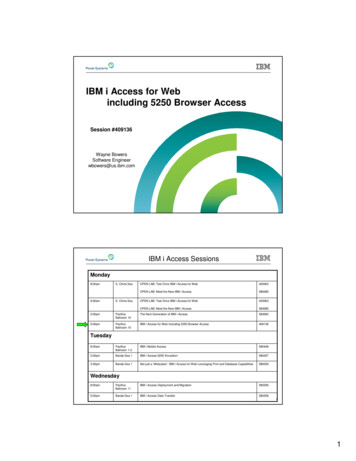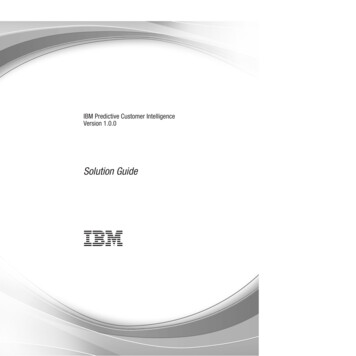
Transcription
IBM Predictive Customer IntelligenceVersion 1.0.0Solution Guide
NoteBefore using this information and the product it supports, read the information in “Notices” on page 87.Product InformationThis document applies to IBM Predictive Customer Intelligence Version 1.0.0 and may also apply to subsequentreleases.Licensed Materials - Property of IBM Copyright IBM Corporation 2014.US Government Users Restricted Rights – Use, duplication or disclosure restricted by GSA ADP Schedule Contractwith IBM Corp.
ContentsIntroduction . . . . . . . . . . . . . . . . . . . . . . . . . . . . . . . . . viiChapter 1. IBM Predictive Customer Intelligence . . . . . . . . . . . . . . . . . . 1Create a Predictive Customer Intelligence solution . 2Chapter 2. Case studies . . . . . . . . . . . . . . . . . . . . . . . . . . . . . 3Telecommunications case study . . . . . . . . . . . . . . . . . . . . . .Use Predictive Customer Intelligence to retain a dissatisfied customer . . . . . . . .Define the offers that customers of a telecommunication company can receive . . . . .Determine the best offers for telecommunications customers by creating business rules . .Build predictive models for a telecommunications company . . . . . . . . . . .Monitor the success of offers . . . . . . . . . . . . . . . . . . . . .Retail case study. . . . . . . . . . . . . . . . . . . . . . . . . . .Predictive retail promotions process . . . . . . . . . . . . . . . . . . .Use Predictive Customer Intelligence to increase revenue through targeted recommendationsDefine the offers to be presented to retail customers . . . . . . . . . . . . . .Determine the best offers for retail customers by creating business rules . . . . . . .Build predictive models for retail promotions . . . . . . . . . . . . . . . .Use Predictive Customer Intelligence to build cross-channel loyalty: in-store promotions .Insurance case study . . . . . . . . . . . . . . . . . . . . . . . . .Use Predictive Customer Intelligence to drive cross-sell opportunities . . . . . . . .Define the offers to be presented to insurance customers . . . . . . . . . . . .Determine the best offers for insurance customers by creating business rules . . . . .Build predictive models for an insurance company . . . . . . . . . . . . . .Energy and Utilities case study . . . . . . . . . . . . . . . . . . . . . .Banking case study . . . . . . . . . . . . . . . . . . . . . . . . . .Use Predictive Customer Intelligence to target promotional offers to the right customer . .Define the offers that banking customers can receive . . . . . . . . . . . . .Build predictive models for a banking customer . . . . . . . . . . . . . . . 3. 4. 7. 8. 10. 10. 11. 11. 12. 13. 14. 15. 16. 17. 17. 18. 20. 20. 21. 22. 22. 23. 24Chapter 3. Predictive models . . . . . . . . . . . . . . . . . . . . . . . . . . 25Data sources . . . . . . . . . . . . . . . . . . . . .Predictive models in the Telecommunications sample . . . . . . .Predicting churn. . . . . . . . . . . . . . . . . . .Customer satisfaction . . . . . . . . . . . . . . . . .Assigning offers . . . . . . . . . . . . . . . . . . .Targeting offers to customers with the response propensity model . .Telecommunications models in Analytical Decision Management . .Predictive models in the Retail sample . . . . . . . . . . . .Prepare data for a retail solution . . . . . . . . . . . . .Defining customer segments . . . . . . . . . . . . . . .Market Basket Analysis . . . . . . . . . . . . . . . .Determine Customer Affinity . . . . . . . . . . . . . .Response log analysis . . . . . . . . . . . . . . . . .Inventory-based suggestion . . . . . . . . . . . . . . .Deployment of models in the Retail sample . . . . . . . . .Use Retail case study models in IBM Analytical Decision ManagementPredictive models in the Insurance sample . . . . . . . . . . .Data used in the Insurance sample . . . . . . . . . . . .Define customer segments in the Insurance sample . . . . . . .Predict churn in the Insurance case study . . . . . . . . . .Understand Customer Lifetime Value (CLTV) . . . . . . . . .Predict customer response to a campaign . . . . . . . . . .Predict churn for auto policy holders . . . . . . . . . . . .Group customers based on their current life stage . . . . . . . Copyright IBM Corp. 445iii
Identify the life policies bought by life stage segments . .Recommend the correct insurance policy . . . . . .Transform and aggregate customer data . . . . . . .Extract life stage event information from social media postsExtract sentiment scores from customer complaints . . .Insurance data model . . . . . . . . . . . . .Predictive models in the Energy and Utilities sample . . .Predict credit rating . . . . . . . . . . . . .Predict the need for demand response program assistance .Recommend the right rate plan . . . . . . . . . .Understand customer sentiment . . . . . . . . .Predictive models in the Banking sample . . . . . . .Determine category affinity in banking . . . . . . .Predict churn in the banking industry . . . . . . .Predict whether customers will default on credit card debtDefine customer segments in the banking industry . . .Sequence analysis . . . . . . . . . . . . . .Training predictive models . . . . . . . . . . . .Scoring a model . . . . . . . . . . . . . . . .Creating business rules . . . . . . . . . . . . .Deployment . . . . . . . . . . . . . . . . .454545464646484849494949505050515151515252Chapter 4. Integration with the IBM Enterprise Marketing Management suite. . . . . . 53IBM Interact connectors . . . .The External Learning connector .The External Callout connector . . 53. 53. 54Chapter 5. Integration with Next Best Action Optimizer . . . . . . . . . . . . . . . 55Open NBAOPT Studio from IBM SPSSGenerating streams from PMML files .Example SPSS stream . . . . .Configuring the IBM SPSS stream . .Modeler. . . . . . .56565758Chapter 6. Reports and portal pages . . . . . . . . . . . . . . . . . . . . . . . 59Sample reports and portal pages . . . . . . . . . .Viewing the sample reports . . . . . . . . . . .Modifying the Predictive Customer Intelligence data model .Predictive Customer Intelligence Usage Report . . . . .Running the Predictive Customer Intelligence Usage ReportThe Framework Manager model for the Usage Report . .596161626363Appendix A. IBM Predictive Customer Intelligence samples . . . . . . . . . . . . . 67Telecommunications sample .Retail sample . . . . . .Insurance sample . . . .Banking sample . . . . .Energy and Utilities sample .6768697071Appendix B. Configuration of the Usage Report . . . . . . . . . . . . . . . . . . 73Predictive Customer Intelligence database tables . . . . . . . . .Configuring logging in IBM Enterprise Marketing Management . . . .Populate the Predictive Customer Intelligence database from EnterpriseConfigure logging in IBM SPSS Collaboration and Deployment . . . .Populate the Predictive Customer Intelligence database from IBM SPSS. . . . . . . . . . . . . . . . .Marketing Management . . . . . . . . . . . . . . . . .7376777880Appendix C. Troubleshooting a problem . . . . . . . . . . . . . . . . . . . . . 83Troubleshooting resourcesiv.IBM Predictive Customer Intelligence Version 1.0.0: Solution Guide. 83
Notices . . . . . . . . . . . . . . . . . . . . . . . . . . . . . . . . . . . 87Index . . . . . . . . . . . . . . . . . . . . . . . . . . . . . . . . . . . . 91Contentsv
viIBM Predictive Customer Intelligence Version 1.0.0: Solution Guide
IntroductionIBM Predictive Customer Intelligence gives you the information and insight thatyou need to provide proactive service to your customers. The information can helpyou to develop a consistent customer contact strategy and improve yourrelationship with your customers.AudienceThis guide is intended to provide users with an understanding of how the IBMPredictive Customer Intelligence solution works. It is designed to help people whoare planning to implement IBM Predictive Customer Intelligence know what tasksare involved.Finding informationTo find product documentation on the web, including all translateddocumentation, access IBM Knowledge Center (http://www.ibm.com/support/knowledgecenter).You can also access PDF versions of the documentation from the PredictiveCustomer Intelligence web page (www.ibm.com/support/docview.wss?uid swg27041723).Accessibility featuresAccessibility features help users who have a physical disability, such as restrictedmobility or limited vision, to use information technology products. Some of thecomponents included in the IBM Predictive Customer Intelligence haveaccessibility features.IBM Predictive Customer HTML documentation has accessibility features. PDFdocuments are supplemental and, as such, include no added accessibility features.Forward-looking statementsThis documentation describes the current functionality of the product. Referencesto items that are not currently available may be included. No implication of anyfuture availability should be inferred. Any such references are not a commitment,promise, or legal obligation to deliver any material, code, or functionality. Thedevelopment, release, and timing of features or functionality remain at the solediscretion of IBM.Samples disclaimerSample files may contain fictional data manually or machine generated, factualdata compiled from academic or public sources, or data used with permission ofthe copyright holder, for use as sample data to develop sample applications.Product names referenced may be the trademarks of their respective owners.Unauthorized duplication is prohibited. Copyright IBM Corp. 2014vii
viiiIBM Predictive Customer Intelligence Version 1.0.0: Solution Guide
Chapter 1. IBM Predictive Customer IntelligenceIBM Predictive Customer Intelligence brings together in a single solution theability to do the following tasks:v Determine the best offer for a customer.v Retain customers that are likely to churn.v Segment your customers, for example, by family status and salary.v Identify the most appropriate channel to deliver an offer, for example, by email,telephone call, or application.This solution ensures that all interactions with customers are coordinated andoptimized. Predictive customer intelligence gives you the ability to sift quicklythrough millions of subscribers and know who to contact, when, and with whataction.The following steps define the process:1. Understand the customer. Predictive modeling helps you to understand whatmarket segments each customer falls into, what products they are interested in,and what offers they are most likely to respond to.2. Define possible actions and the rules and models that determine whichcustomers are eligible for which offers.3. After the best action is identified, deliver the recommendation to the customer.Optionally, you can monitor the effectiveness of your solution by using the UsageReport that is provided. The Usage Report displays the number of offers that arepresented to customers and can be configured to show the number of offers thatare accepted and rejected. For more information, see “Predictive CustomerIntelligence Usage Report” on page 62.Integration with the IBM Enterprise Marketing Management(EMM) suiteIBM Predictive Customer Intelligence integrates with the following solutions:v IBM Campaign, a web-based solution that enables users to design, run, andanalyze direct marketing campaigns.v IBM Interact, which provides personalized offers and customer profileinformation in real time.v IBM Marketing Platform, which provides security, configuration, and dashboardfeatures for IBM EMM products.IBM Predictive Customer Intelligence provides two connectors between IBMInteract and IBM SPSS Collaboration and Deployment Scoring Service:v The External Callout connector calls an IBM SPSS model at run time, and iscontained within the expression of an advanced rule for a marketer score,overriding the score that is supplied by the EMM campaign.v The External Learning connector extends IBM Interact's native learning moduleto monitor visitor actions and propose optimal offers. It prioritizes IBMCampaign offers based on an IBM SPSS model's prediction of their final score.The connector passes specific configurable parameters as input to the IBM SPSSScoring Service. Copyright IBM Corp. 20141
Integration with the IBM Next Best Action OptimizerIBM Next Best Action Optimizer (NBAOPT) segregates customers by lifetimevalue, and then provides recommended actions to retain customers, which arebased on their lifetime value segment.You can integrate NBAOPT with the IBM Predictive Customer Intelligencesolution. Install the NBAOPT connector to add an NBAOPT item to the IBM SPSSModeler Tools menu. You can start the NBAOPT Studio from this menu, and youcan generate a stream from PMML files.Create a Predictive Customer Intelligence solutionSample files are supplied to help you to design an IBM Predictive CustomerIntelligence solution for the needs of your business.Samples for the following industries are included:v Telecommunicationsv Retailv Insurancev Energy and Utilitiesv BankingCase studies that describe common scenarios for each industry where PredictiveCustomer Intelligence can be used are provided. See Chapter 2, “Case studies,” onpage 3.For information about installing the samples, see IBM Predictive CustomerIntelligence Installation Guide for Microsoft Windows Operating Systems, or IBMPredictive Customer Intelligence Installation Guide for Linux Operating Systems.2IBM Predictive Customer Intelligence Version 1.0.0: Solution Guide
Chapter 2. Case studiesCase studies illustrate common scenarios where IBM Predictive CustomerIntelligence can be used to provide prioritized offers to your customers.Telecommunications case studyTelecommunications providers are leaders in harnessing big data, for example:billing data, demographic data such as gender, age, and employment status,transaction history, call detail records, and call center records.The key to success is bringing different data sources together, such as structureddata, unstructured data, internal data, and external data, to create a profile of eachcustomer. By constantly analyzing all of these information types, IBM PredictiveCustomer Intelligence provides you with insights that you can use to build aservice that is fine-tuned to a customer’s specific needs.This case study demonstrates how IBM Predictive Customer Intelligence can beused in the telecommunications industry to retain a dissatisfied customer:Retain a dissatisfied customerA call center agent uses the data in the call center application to do thefollowing activities:1. Recognize that the customer is dissatisfied through analysis of networktraffic and call detail records.2. See that the customer is high value.3. See what actions and offers the customer is eligible for.4. Proactively submit an action for a service level request to fix issues,and contact the customer with an offer.Determine which offers customers receive based on profile and real-time dataUsing IBM Campaign, the marketing manager determines which offerscustomers can receive based on their customer profile data and theirreal-time interaction data. For example, a new product inquiry, acomplaint, or a data plan inquiry.Determine the best offers for customers by creating business rulesUsing IBM Analytical Decision Management, the business analyst createsbusiness rules to determine which actions are valid for a customer. Forexample, you might create a rule that targets retention actions to customerswith high network influence, high churn risk, and no open cases.Predict churn, customer satisfaction, and propensity to respond to offers bycreating predictive modelsUsing IBM SPSS Modeler, a data modeler creates predictive models topredict the following factors:v A customer's propensity to churn.v Customer satisfaction.v Propensity to respond to offers.The results from these models are used in Analytical DecisionManagement. Copyright IBM Corp. 20143
Monitor the success of offersMarketing managers and business analysts can monitor the success ofoffers with the Usage Report. The Usage Report provides a snapshot ofhow many offers were presented to customers by channel and by month.Use Predictive Customer Intelligence to retain a dissatisfiedcustomerBill is the customer of a telecommunications firm and is experiencing excessivedropped calls and handset issues. This case study describes how IBM PredictiveCustomer Intelligence can be used to help to retain Bill, who is a high valuecustomer.This example demonstrates how IBM Predictive Customer Intelligence coordinatesthe telecommunications company’s interactions with its customers, ensuring thatcustomers are contacted at the right time, through the right channel, and with thebest possible actions. It uses the following architecture: The call center applicationconnects directly to IBM Enterprise Marketing Management (EMM) by using theIBM EMM API.Customer profileBill is a professional architect and a small business owner. He is married but withno children. He has a single mobile account with the telecommunications providerthat he uses both for business and personal use.Bill is an extensive social and mobile application user. He does extensive webbrowsing and makes many telephone calls.Bill is a high value customer, one the company wants to retain. However, Bill isdissatisfied. Analysis of network traffic and call detail records show that Billrecently had a number of dropped calls, he called a competitor’s call center, and hehas two hardware issues with his phone.Carolyn, a call center agent initiates an outbound call to Bill. She opens herCustomer Relationship Management (CRM) software and looks at Bill's profile.From a dashboard interface, she sees three alerts that require her attention:v Bill is eligible for support.v He is eligible for offers.v Bill is at great risk of leaving the company.Figure 1. Dashboard notifications that shows alerts4IBM Predictive Customer Intelligence Version 1.0.0: Solution Guide
Carolyn can also see some metrics for Bill. The data is provided by IBM SPSSpredictive models and displayed in Cognos Business Intelligence reports:v His churn score is High.v Customer Satisfaction is Low.v Customer Lifetime Value is High.v Social Influence is High.Figure 2. Dashboard profile that shows metricsThese metrics indicate that Bill is a valuable and influential customer who is at riskof leaving.Carolyn can see that Bill has a history of issues with his phone. She can seethrough real-time sentiment analysis of Twitter feeds that Bill is experiencingproblems with dropped calls, which he has not yet reported to the service center.Real-time detection of dropped calls is causing the dropped call indicator to reacha critical threshold, which the agent sees identified.Bill is not happy with his current phone. The company needs to intervene to retainBill as a customer.ActionsCarolyn looks up at the Notification area at the top of her CRM screen to see theavailable Actions for Bill.Figure 3. Notifications area that shows actionsThe second action is a proactive service request that can be submitted by Carolynon behalf of Bill. This action addresses the dropped call issue that Bill experienced.Carolyn selects the support action and clicks Submit Response.Chapter 2. Case studies5
Carolyn tells Bill that she is submitting a Level 1 service request on his behalf tofix the dropped call issues that he experienced. She tells him that the issues will befixed immediately so that he can continue to have uninterrupted service. Bill isimpressed that his service provider detected the issue without him calling in toreport it, and took proactive steps to have the dropped call issues fixed.Due to Bill’s recent hardware issues, Carolyn also offers Bill a free upgrade to apremium phone. Bill readily accepts the offer of a new phone.After Carolyn submits his response, Bill’s scores are updated. His Churn score nowshows a reduced risk. It is now at 55%, which is down from the previous 75%.Both his Satisfaction and Customer Lifetime Value scores increased.Figure 4. Dashboard profile that shows updated metricsOptimization of offersYou can further optimize offers. Following on from the previous example, connectthe call center application to IBM Analytical Decision Manager, and then connectAnalytical Decision Manager to your existing IBM EMM campaigns by using theExternal learning connector.The External learning connector provides different offers for Bill, under the samecircumstances. He is offered:v Route to Level 1 support.v Initiate Network Service Request.These options are less expensive to the Telecommunications company, but areequivalent in reducing churn and increasing satisfaction.Offer optimization workflowThe following steps demonstrate how IBM Predictive Customer Intelligencedetermines the offers to be presented to Bill by using the External Learningconnector.1. Open customer profileCarolyn, the call center agent, types Bill's phone number in the CustomerRelationship Management (CRM) system and clicks Search.2. Obtain actions and alertsThe CRM system passes a set of parameters to the IBM EnterpriseMarketing Management (EMM) Interact Web Service as a request using theInteract API. The Interact web service outputs the offers.3. Personalize offersThe Interact web service passes a set of parameters including the offers to6IBM Predictive Customer Intelligence Version 1.0.0: Solution Guide
the IBM SPSS Scoring Service using the External Learning connector. TheExternal Learning connector returns a score for each offer to the call centeragent system.4. Reorder offersThe CRM system sorts the list of offers using the score. The CRM systemthen calls the IBM SPSS Scoring Service with the list of offers and othercustomer parameters using the Scoring Service API. An IBM AnalyticalDecision Management model is activated.5. Get more offersIBM Analytical Decision Management issues new offers to the CRM systemthrough the IBM SPSS Scoring Service. The offers are displayed in theCRM system.6. Run reportsThe CRM launches the report that is generated by IBM Cognos BusinessIntelligence.7. Submit customer responseCarolyn presents the offers to Bill, and clicks Submit Response when heaccepts.8. Re-run modelsThe call center agent system passes a set of parameters to the IBM SPSSScoring Service as a request using the Scoring Service API. The IBM SPSSweb service re-runs the applicable models and outputs the parameters ofthe model results. Bill's customer profile is updated in the database.9. Obtain actions and alertsThe CRM system passes a set of parameters to the Interact web service asa request using the Interact API. The Interact web service outputs theoffers. If there are no further actions, the process stops here. If there areany further actions and alerts, the process goes back to the Personalizeoffers step.Define the offers that customers of a telecommunicationcompany can receiveMonica is a marketing manager who is responsible for defining her company’smarketing strategy. She determines which offers individual customers can receivebased on their customer profile data and their real-time interaction data.Customer profile data and real-time dataThe customer profile data can include the following:v Customer behavioral data, call, and text volume, products owned, contractdetails.v Customer demographic information and contact preferences.v Predictive model scores.v Social data.v Sentiment.v Prior transactions and campaign responses.Real-time data can be found in the context of the current call, such as a newproduct inquiry, a complaint, or a data plan question.Chapter 2. Case studies7
The campaignMonica creates a campaign that is named Telco Call Center Campaign by usingIBM Campaign, part of the IBM Enterprise Marketing Management (EMM) suite.The Telco Call Center Campaign contains offers to be presented within the callcenter application. The details of the offer vary based on individual customercharacteristics. The results of the offer, whether accepted or rejected, are recordedin the customer's interaction history, and that information can be used forfollow-up marketing offers and campaigns.Customers are segmented into categories in real time, based on the context of thecall, real time scoring, and the campaign's business rules.For example, you might have a flowchart with a decision node that assignscustomers to five categories:v HighValuev ProductInquiryv Complaint LowValuev Complaint HighValuev CloseAccountIn this example, customers are assigned to the HighValue segment if they have acustomer lifetime value ratio greater than 0.7.Each segment is assigned specific offers. Offers can be enabled or disabled by themarketer as the marketing strategy changes.The HighValue customers qualify for the following potential offers:vvvvPremiumPremiumPremiumA secondphone.data plans.family plan.line at no cost.Offer eligibility criteria for customers is based on calculations that use the real-timecustomer data and offer definition attributes.After each offer is evaluated, there might be more offers eligible than there is timeor space to present. For example, a customer is eligible for three offers, but youwant to present only the top two offers. In this case, the offers would be presentedbased on the marketer's score values. The marketer's score can be based on acalculation of an expression by using customer and offer attributes, a real timelearning algorithm, or a combination of these methods.Determine the best offers for telecommunications customersby creating business rulesAlex is a business analyst. He uses IBM Analytical Decision Management to bringtogether his company’s business rules, predictive models, and optimizations todetermine the best possible offer for a customer.Alex creates business rules to determine which actions are valid for any singlecustomer. Some examples of what you might set up business rules for are shownin the following list:8IBM Predictive Customer Intelligence Version 1.0.0: Solution Guide
vvvvvRetentionBillingServiceSupportMarketingThe telecommunications company has a retention campaign. Alex targets retentionactions to customers with high network influence, high churn risk, and no opencases.Offers are allocated so that the first offer in the list that applies is presented to thecustomer.For example, customers are offered a premium phone if the following is true:v Offer1 equals premium phone. This value was assigned by IBM EnterpriseMarketing Management.v Current Offer does not equal premium phone. The current offer is what was onrecord in the customer’s profile, generated from the last time an offer was madeto the customer. You do not want to offer the same thing to a customer twice.v The association model is a segmentation model that determines whether acustomer is a promoter or a detractor, and whether the customer is amenable tooffers.If a customer qualifies for multiple offers, these offers can be prioritized.You can set the maximum number of offers (Max number of offers) to bepresented to each customer, for example, two.You can apply an optimization equation to each action that is valid for a customer.The aim in the example is to pick the top two actions. When the equation isapplied, the actions with the highest two scores are presented to the customer.RESPONSE PROPENSITY * (REVENUE (LOYALTY * (CHURN * FUTURE REVENUE)))The equation contains the following key attributes:v Propensity to respond to the offer.v Revenue the offer would bring in.v How much impact the action would have on customer loyalty and churn.v Predicted future revenue.Not all data needs to come from rules that are created in IBM Analytical DecisionManagement. Some data can be defined elsewhere and imported into AnalyticalDecision Management. The key is to bring the intelligence together in one placeand to orchestrate the final decision within a single application:v Predictive models can be built in another tool by a data miner.v Marketing campaigns and offers can be defined by a marketer.v Data can be made available in the right form for modeling and deployment byan information architect.For more information, see the IBM Analytical Decision Management ApplicationUser’s Guide A3P ps/user overview container.htm).Chapter 2. Case studies9
Build predictive models for a telecommunications companyDavid, the data scientist (or data engineer), builds models using IBM SPSSModeler to make the f
Contents Introduction .vii Chapter 1. IBM Predictive Customer Intelligence .1 Create a Predictive Customer Intelligence solution.2

